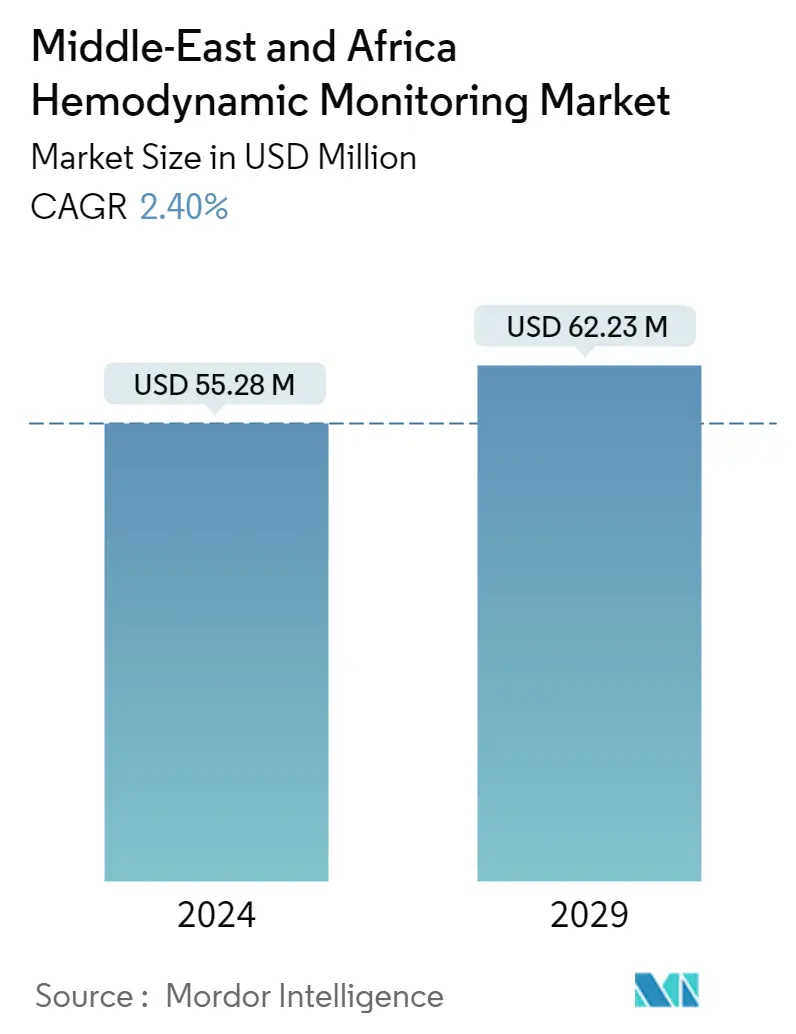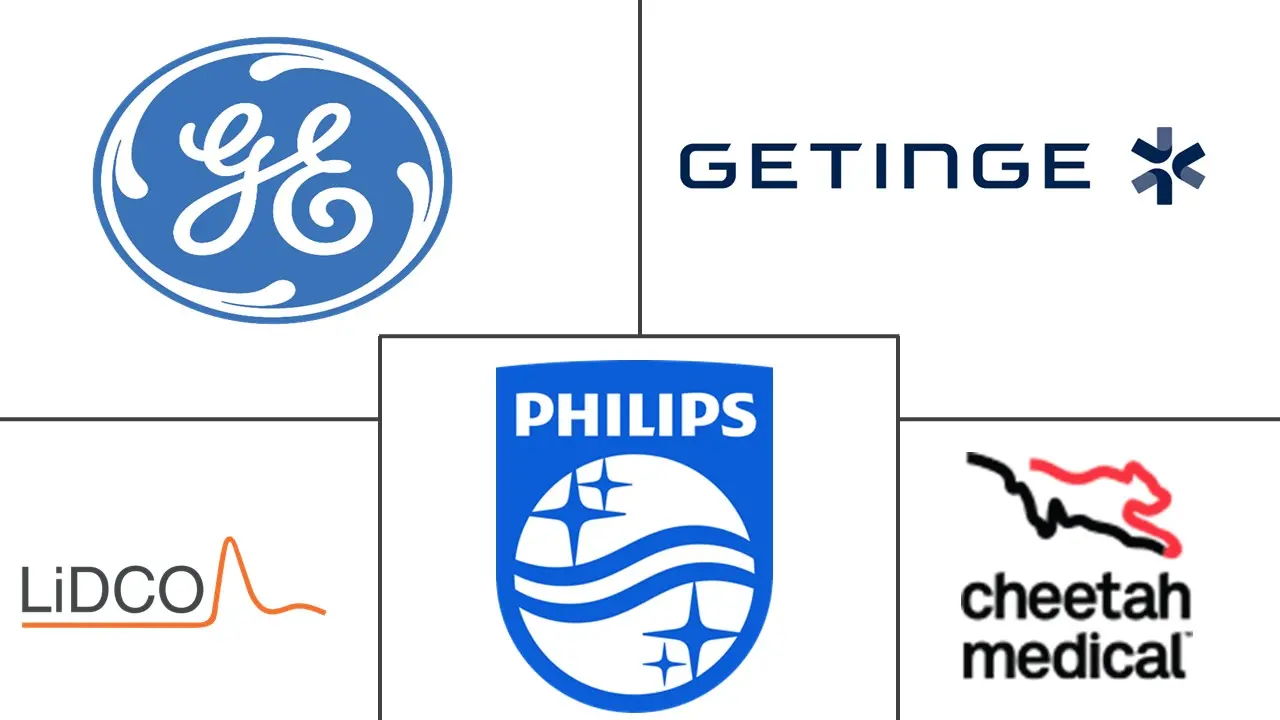Market Size of Middle-East & Africa Hemodynamic Monitoring Industry

| Study Period | 2019 - 2029 |
| Base Year For Estimation | 2023 |
| Forecast Data Period | 2024 - 2029 |
| Market Size (2024) | USD 55.28 Million |
| Market Size (2029) | USD 62.23 Million |
| CAGR (2024 - 2029) | 2.40 % |
Major Players
*Disclaimer: Major Players sorted in no particular order |
MEA Hemodynamic Monitoring Market Analysis
The Middle-East & Africa Hemodynamic Monitoring Market size is estimated at USD 55.28 million in 2024, and is expected to reach USD 62.23 million by 2029, growing at a CAGR of 2.40% during the forecast period (2024-2029).
The key factors propelling the growth of this market are an increase in the number of critically ill geriatric cases, rise in the prevalence of cardiac disorders and diabetes, increasing demand for home-based and non-invasive monitoring systems, advances in technology, due to funding by private players and government bodies, and increase in the number of people suffering from hypertension.
According to the World Population Ageing 2019 report, in Saudi Arabia, the population aged 65 years or over in 2019 was 1.169 million (3.4%), and this number is projected to reach to 2.379 million (6.0%) in 2030. As the elderly population is expected to grow in the coming years, and the elderly are more prone to chronic diseases, such as cardiovascular diseases, obesity and diabetes, the market is expected to experience growth in the future.
Thus, owing to the above factors the market is expected to show significant growth over the forecast period.
MEA Hemodynamic Monitoring Industry Segmentation
As per the scope of the report, critically ill patients require continuous monitoring of their vital parameters. This is done by direct pressure monitoring systems, which are also known as hemodynamic systems. The main function of these systems is to monitor cardiac activity. The hemodynamic systems give information about blood pressure, blood volume, and fluid balance. The Middle-East & African Hemodynamic Monitoring Market is segmented by system, application, and geography.
| By System | |
| Minimally Invasive Monitoring Systems | |
| Invasive Monitoring Systems | |
| Non-invasive Monitoring Systems |
| By Application | |
| Laboratory-based Monitoring Systems | |
| Home-based Monitoring Systems | |
| Hospital-based Monitoring Systems |
| Geography | |||||
|
Middle-East & Africa Hemodynamic Monitoring Market Size Summary
The Middle-East & Africa Hemodynamic Monitoring Market is poised for growth, driven by several key factors. The increasing prevalence of critically ill geriatric cases, alongside a rise in cardiac disorders and diabetes, is significantly contributing to market expansion. The demand for home-based and non-invasive monitoring systems is also on the rise, supported by technological advancements fueled by both private and government funding. The growing elderly population, particularly in regions like Saudi Arabia, is expected to further propel the market, as this demographic is more susceptible to chronic conditions such as cardiovascular diseases, obesity, and diabetes. Minimally invasive systems are gaining traction for their ability to provide continuous and dynamic hemodynamic monitoring, offering improved assessment of fluid responsiveness and cardiac output.
The competitive landscape of the Middle-East & Africa Hemodynamic Monitoring Market is characterized by the presence of several major players, including Getinge Group, Koninklijke Philips NV, LiDCO Group PLC, and GE Healthcare, who hold substantial market shares. However, the market is also witnessing increased activity from mid-size to smaller companies that are leveraging technological advancements and product innovations to enhance their market presence. These companies are introducing new devices at competitive prices, contributing to the dynamic nature of the market. The LiDCOplus monitor, for instance, offers continuous and accurate assessments of hemodynamic status, highlighting the ongoing innovation within the sector.
Middle-East & Africa Hemodynamic Monitoring Market Size - Table of Contents
-
1. MARKET DYNAMICS
-
1.1 Market Overview
-
1.2 Market Drivers
-
1.2.1 Increasing Geriatric Population and Rise in the Prevalence of Cardiac Disorders and Diabetes
-
1.2.2 Increasing Demand for Home-based and Non-invasive Monitoring Systems
-
1.2.3 Increasing Number of People Suffering from Hypertension
-
-
1.3 Market Restraints
-
1.3.1 Increasing Incidences of Complications Associated with Invasive Monitoring Systems
-
1.3.2 Precision of CO Determinations Adversely Affected Under Low Flow Conditions
-
-
1.4 Porter's Five Force Analysis
-
1.4.1 Threat of New Entrants
-
1.4.2 Bargaining Power of Buyers/Consumers
-
1.4.3 Bargaining Power of Suppliers
-
1.4.4 Threat of Substitute Products
-
1.4.5 Intensity of Competitive Rivalry
-
-
-
2. MARKET SEGMENTATION
-
2.1 By System
-
2.1.1 Minimally Invasive Monitoring Systems
-
2.1.2 Invasive Monitoring Systems
-
2.1.3 Non-invasive Monitoring Systems
-
-
2.2 By Application
-
2.2.1 Laboratory-based Monitoring Systems
-
2.2.2 Home-based Monitoring Systems
-
2.2.3 Hospital-based Monitoring Systems
-
-
2.3 Geography
-
2.3.1 Middle-East & Africa
-
2.3.1.1 GCC
-
2.3.1.2 South Africa
-
2.3.1.3 Rest of Middle-East & Africa
-
-
-
Middle-East & Africa Hemodynamic Monitoring Market Size FAQs
How big is the Middle-East & Africa Hemodynamic Monitoring Market?
The Middle-East & Africa Hemodynamic Monitoring Market size is expected to reach USD 55.28 million in 2024 and grow at a CAGR of 2.40% to reach USD 62.23 million by 2029.
What is the current Middle-East & Africa Hemodynamic Monitoring Market size?
In 2024, the Middle-East & Africa Hemodynamic Monitoring Market size is expected to reach USD 55.28 million.

